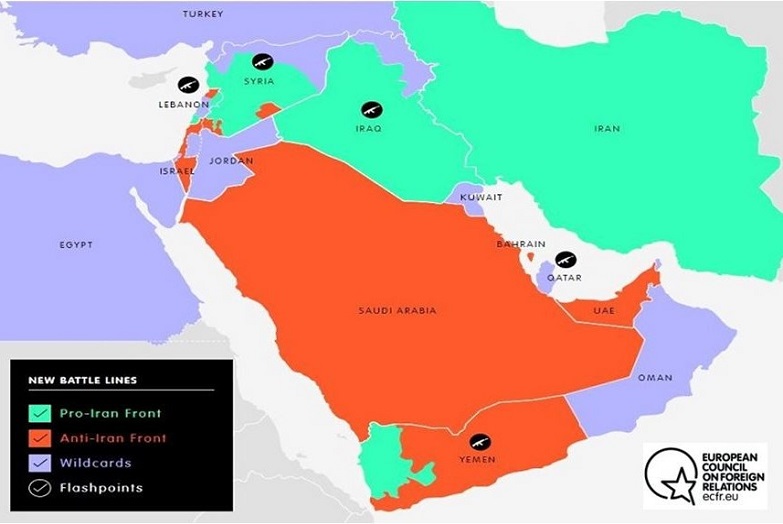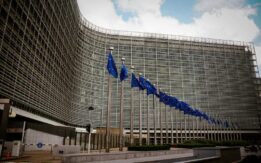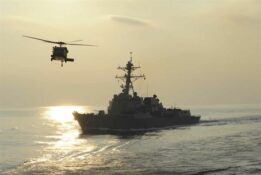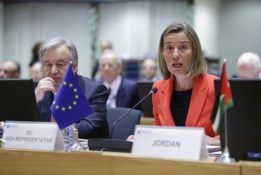Cet article dévoile la dynamique qui façonne les nouvelles lignes de front au Moyen-Orient. Les auteurs dressent le constat d'une centralité de la confrontation entre l’Iran et ses partisans, étatiques ou non-étatiques, et les alliés traditionnels de l’Occident dans la région. Ils soulignent un fort risque d’exacerbation de cette confrontation en un véritable conflit régional, voire international. Alors que la décision américaine de retrait de l’accord nucléaire avec l'Iran a accru le niveau de tension, les auteurs considèrent que l’Europe peut et doit tenter de réduire les points de friction entre les protagonistes, et ils avancent différentes propositions pour ce faire.
Les opinions exprimées dans cet article n’engagent pas le CSFRS.
Les références originales de ce texte sont : Julien Barnes-Dacey, Ellie Geranmayeh, Hugh Lovatt, « The Middle East new battle lines« , ECFR.
Ce texte, ainsi que d’autres publications peuvent être visionnés sur le site de l’ECFR :
Vous pouvez également accéder à la carte en illustration dans sa version interactive au lien suivant : http://www.ecfr.eu/mena/battle_lines/
The Middle East new battle lines
Two opposing coalitions in the Middle East define a rivalry that threatens to tear the region apart. As competition for dominance intensifies, the confrontation between Iran’s network of state and non-state actors, and a counter-front of traditional Western allies – centred on Saudi Arabia, the United Arab Emirates, and Israel – has become the region’s central battle line. The fault-line between the two coalitions has already become the axis on which regional politics turns, and the key to understanding many geopolitical developments in the Middle East.
This dynamic is not entirely new: the rivalry between Riyadh and Tehran, played out through a series of proxy conflicts, has been one of the defining characteristics of the region for at least the past decade. But in recent years, their rivalry has metastasised across the region and taken in new allies on both sides. As regional battlefields become more numerous and more interlinked, there is a growing risk that a localised spark will set off a direct inter-state conflagration that engulfs the wider region, perhaps even drawing in Russia and the US. President Donald Trump’s decision to withdraw the US from the nuclear agreement with Iran now risks adding considerable fuel to the fire, particularly given that there are hints the US administration has ambitions for regime change in Iran. These trends are significantly heightening mutual tensions and reintroducing nuclear competition into febrile regional rivalries.
Syria shows the dangers – a single battlefield there hosts a confusing complex of overlapping struggles. In February 2018, for example, an Iranian drone from a base established to fight the Syrian civil war, launched an incursion into Israel. The drone provoked massive Israeli military retaliation and, in turn, the downing of an Israeli fighter jet by Syrian antiaircraft missiles. This has been followed by intensified direct Israeli targeting of Iranian military personnel and bases in Syria, exacerbating fears that a wider war between the two states could be imminent. There is no longer any such thing as a local conflict in the Middle East. The risk of direct interstate war is intensifying.
This report aims to unpack the developing fault-line. It maps Iran’s coalition of allies and regional influence and the counter-coalition that has formed to oppose them. It contains essays that describe the positions and motives of all key regional actors. Further pieces then map the key flashpoints – a series of interlinked conflicts throughout the region – and describe how they form part of the larger regional dispute. And it considers how European countries can position themselves to effectively preserve their interests, which are linked to Middle Eastern conflicts through geographic proximity, refugee flows, and the spread of extremism.
Europeans have so far resisted the urge to fully embrace the anti-Iran coalition. But concerns about Tehran’s regional behaviour, combined with intense pressure from regional allies and now failed attempts to prevent the US from abandoning the Iran nuclear deal, have pushed Europeans to harden their positions. Iran’s regional role is problematic and merits a response, but this report argues that Europeans should not encourage an approach that sees confrontation as the only means of achieving this goal. Such an approach will be counterproductive, playing to Iran’s strengths and triggering widening conflict. In the aftermath of Trump’s hard exit from the nuclear deal, it will become ever more imperative that Europeans assert this position to avert what increasingly appears a dangerous rush into a new regional conflagration.
The challenge: Iran’s regional influence
As European and regional states look across the Middle East, they see an unprecedented level of Iranian influence. Tehran exercises varying degrees of control in Iraq, Lebanon, Syria, and Yemen – far more than it did before the US’ 2003 invasion of Iraq. Europe’s traditional allies – the Gulf Cooperation Council (GCC) states and Israel – see Iran’s military influence through its network of partners as a direct threat to their security.[1]
Tehran has carefully cultivated a network of state and non-state regional allies that now find themselves in the ascendancy. In Iraq, the political class broadly aligns with Tehran. Iran’s Islamic Revolutionary Guard Corps (IRGC) is intertwined with the Iraqi security apparatus, particularly through the array of militia and paramilitary forces that arose in the fight against the Islamic State group (ISIS).[2] In addition to its connections to the Shia Iraqi political elite, Iran has engaged in extensive social outreach to Iraq’s Shia community and encouraged millions of Iranian pilgrims to travel to Iraq annually. Iran is an important trade partner for Iraq and has also invested in the Kurdistan region where it is a crucial electricity provider.[3] These relations are likely to intensify and expand into new areas – for example, Baghdad and Tehran recently announced plans to revive a project for a pipeline that will carry oil from Iraq’s Kirkuk to Iran, for export to third countries.[4]
In Lebanon, Iran’s close ally Hezbollah dominates both the political and military spheres, effectively holding veto power over state decision-making. For Iran, Hezbollah is a successful model of an allied non-state actor that can dominate the security sphere and eventually take centre stage in the political realm.
In Syria, meanwhile, the popular uprising against Bashar al Assad – whose father was one of Tehran’s few backers during the 1980-88 Iran-Iraq War – led the Iranians to increase their support for the regime. IRGC and Iranian-backed ground forces – largely deployed in militia form, with recruits from Syria, Iraq, and Afghanistan – have been instrumental in ensuring Assad’s survival and effective victory. As the Syrian conflict continued, the latest Saudi military engagement in Yemen, which began in 2015, created a new opening for Iran – which increased its assistance for Houthi fighters, allegedly through transfers of ballistic missile technology and other military aid.[5]
Drivers of Iran’s regional strategy
There are two key drivers of Iran’s regional strategy. Firstly, Iran seeks to deter what it views as a real and imminent threat from militarily superior external actors. Iran’s conventional military is no match for that of Israel or Saudi Arabia, let alone the US – all of which Iranian leaders see as intent on engineering regime change in Tehran. Trump’s embrace of key proponents of military intervention, such as National Security Advisor John Bolton, has reinforced this sentiment in Tehran.[6] Iran has adopted asymmetric tactics to address this power imbalance, using allies such as Hezbollah to retain the ability to strike its enemies at range and thereby deter direct attacks. It has also maintained a missile programme that acts as another deterrent against direct attack by more heavily armed regional foes.[7]
Secondly, and closely intertwined with its threat perceptions, Iran demands a significant political role in shaping the regional balance of power.[8] In Tehran’s view, the US and its regional allies have sought, and failed, to contain Iran through economic, military, and political means.[9] Driven by a mixture of nationalism and ideology, Iran rejects any regional order that aims to exclude it. It seeks to use its military presence on the ground to shape political outcomes that preserve its interests.[10]
On this basis, Iran has adeptly taken advantage of a series of strategic openings that have come its way. From postinvasion Iraq to the Yemen war – the latter of which it likely sees as a low-cost opportunity to mire Riyadh and its allies in intractable conflict – Tehran has exploited its circumstances with great dexterity. Iran’s ability to cultivate and empower non-state actors, often in an overtly sectarian fashion, during times of conflict has been one of its greatest strengths.
Iran has consistently succeeded in navigating convoluted regional alliances. The country has even been able to maintain, and deepen, its relations with Turkey and Qatar, deconflicting its activities and theirs despite supporting the other side in the Syrian war. The recent downturn in relations between Saudi Arabia, Turkey, and Qatar has provided a further opening for Iran to strengthen its ties with these countries.[11] More broadly, Iran has used shared interests in Syria to secure a widening strategic relationship with Russia.[12]
Iran’s pragmatism has at times outweighed its anti-Western ideology. Despite its enmity with the US, Tehran has been open to negotiating with Washington in the interests of national security – such as after the US-led invasions of Iraq and Afghanistan, and over the Iranian nuclear programme.
To be sure, Iran faces constraints on its regional activities. Tehran’s friends maintain a degree of independence and may well push for more in ways that mean they are not wholly subservient to Iranian interests. Despite having a close affinity with Tehran, the Assad regime and the government of Haider al-Abadi in Iraq have been eager to limit their dependence on Tehran. Abadi has maintained strong ties to Washington and sought to improve relations with Saudi Arabia.[13] Meanwhile, Assad has leaned on Russia as its global supporter, thereby denying Iran the decisive role as final arbiter in the Syrian conflict.
Iran’s strategy also has rising costs. The country now bears responsibility for stabilising the position of its assets across the region, a task that will only become more challenging amid rising regional opposition to its activities. At home, the economic cost of Iran’s activities has been the subject of internal criticism, most vocally during the December 2017 protests.[14] Moreover, Iran’s rivals have worked to impede its economic rehabilitation under the nuclear agreement, which eased sanctions on the country – an effort that that is likely to intensify as Washington works to prevent Iran from reaping any benefits from a nuclear deal that no longer involves the US.
The June 2017 terrorist attacks in Tehran, the first ISIS claimed in the Iranian capital, also dented the IRGC’s arguments for fighting ISIS in the region, by demonstrating that these interventions can instigate rather than prevent retaliatory attacks at home. The Assad regime’s use of chemical weapons in Syria, anathema in Iran since Saddam Hussein’s use of gas during the Iran-Iraq War, has also occasionally spurred heated internal debate on Iran’s role in the conflict.
For now, Iran finds these costs manageable. As Kayhan Barzegar highlights in his essay presenting the Iranian view, Tehran sees its deterrence posture as having effectively protected the country against local threats and balanced the conventional military asymmetry with US-backed actors. The essay emphasises Iranian leaders’ conviction that US and Arab policy designed to confront Iran will ultimately fail.
Ongoing regional conflict may prompt greater international and internal scrutiny of Iran’s role. But, as demonstrated by the shifting regional balance of power, decades of biting economic sanctions and internal dissent have not proven effective in weakening Iran’s hand. So long as a large number of US troops are stationed in Iraq and Afghanistan near Iran’s borders, the IRGC is likely to retain an active security presence across the region. Dissent within Iran will likely have little effect on the IRGC’s decision on this. External pressure – either through Western condemnation, IRGC-specific sanctions, or military pushback – have also been unsuccessful in forcing Iran to fundamentally change its behaviour.
The emerging response: confronting Iran
Iran’s regional rivals view its growing influence as an acute challenge. For Saudi Arabia and the UAE, Tehran poses a threat to both their position in the region and – through Iranian efforts to empower Sunni and Shia extremists – their domestic stability.[15] Riyadh views Iran’s support for Shia groups in Yemen, Bahrain, and Saudi Arabia’s Eastern Province as a particularly direct threat to Saudi interests. Israel sees its greatest strategic threat in the growing presence of Iranian-affiliated groups near its borders (first in Lebanon and now in Syria), as well as in Tehran’s nuclear and ballistic missile ambitions.[16]
Israel, the UAE, and Saudi Arabia have converged on the common objective of containing and ultimately rolling back Iranian regional influence. These actors share a belief that Iran can only be confronted through force. They regard any attempts to engage with the country diplomatically as futile and dangerous – both because Tehran will never stand down of its own volition and because this process would legitimise unacceptable Iranian gains in the region.[17]
A key force deepening this anti-Iran position has been the strong encouragement of the current US administration, which has made countering Iran the rhetorical centrepiece of its regional strategy.[18] One motive for the administration’s approach is its deeply held conviction that Iran is, after ISIS, the main threat to the US-backed regional order; another is President Trump’s desire to chart a course different to that of his predecessor.
As Eran Etzion and Mohammed Alyahya note, Trump’s hawkish posture has energised the anti-Iran front to push forward attempts to confront Tehran and its proxies more actively than ever. This stands in stark contrast to the Obama administration’s push for regional powers to reach an accommodation with one another, a position that dampened their ability and willingness to challenge Tehran.[19]
From the viewpoint of Sunni Gulf states and Israel, the advent of a new, hawkish US administration has provided a welcome opportunity to contain Iran in a way that was impossible under the previous president.[20] Regional powers that have encouraged the collapse of the nuclear deal see Trump’s withdrawal from the agreement as the on-ramp to a broader US push against Iran’s regional position. In this, the White House has actively encouraged the coordination of regional anti-Iran efforts and promoted greater regional ownership of the fight against Tehran on the ground (part of the attempt to reify its “America First” approach).[21]
The US administration likely sees these anti-Iran efforts as the foundation of a new regional architecture that can advance the interests it shares with Israel, its key Middle East ally. The White House sees a consolidated anti-Iran front as a potentially important way to accelerate the normalisation of relations between Israel and Sunni Gulf states – and, possibly, to open the way for progress towards an Israeli-Palestinian peace deal favourable to Israel.[22]
Indeed, there is evidence that shared antipathy towards Iran is speeding up this process of normalisation.[23] As Etzion writes, Israel views Saudi Crown Prince Mohammed bin Salman as a partner in reviving the concept of a strategically important Sunni-Israeli “land bridge” stretching from the Gulf to Israel via Jordan. Prime Minister Binyamin Netanyahu also views the improvement in ties with Riyadh as an effective means of sidelining the Palestinian issue. This growing Israeli-Sunni cooperation is occurring through incremental economic openings, increased intelligence sharing, and low-level security cooperation, including in Yemen.[24] There has also been a thaw in the sides’ diplomatic relations, reportedly through an increasing number of clandestine meetings between senior Gulf and Israeli officials.[25] As part of this close cooperation, Riyadh and Abu Dhabi now talk about sharing responsibility for “stepped up strategic pushback” that the US will backstop through increased support, including supplies of advanced military hardware.[26]
The challenges facing the anti-Iran front
Despite the convergence of interests – and US support – the formation of a viable and active coalition remains some way off. While Saudi Arabia, the UAE, and Israel have coalesced around a broad anti-Iran goal, major obstacles prevent them from operating as a coalition. This stands in contrast to Tehran’s greater ability to mobilise its resources and allies with single-minded focus, despite its own constraints.
While Israel and the Gulf states have unquestionably grown closer to one another, there are clear limitations on how far this can continue without progress on the Palestinian issue.[27] As Alyahya warns, although Saudi Arabia is interested in drawing closer to Israel, the “intersection” between Saudi and Israeli interests in confronting Iran is not complete. It seems unlikely that Riyadh can muster enough public support and regional diplomatic cover to undertake joint military operations, and normalise diplomatic relations, with Israel unless the latter makes progress on the peace process with Palestine – something it continues to show no interest in.[28]
Moreover, Riyadh has significant operational constraints. Saudi Arabia cannot devote significant resources to a broad confrontation with Iran. It is limited by the weakness of the Saudi military, internal challenges related to Mohammed bin Salman’s domestic consolidation of power and economic agenda, and pressing foreign policy priorities in Yemen and Qatar. While these considerations have not reduced Riyadh’s determination to counter Iranian influence, these limitations have for the moment forced it to disengage from the Syrian war, walk back efforts to challenge Tehran’s power in Lebanon, and shift towards a more conciliatory path in Iraq.
Israeli officials doubt that Riyadh can provide meaningful support in the anti-Iran fight. As Israel addresses the role of Iran in Syria and Lebanon, it has mostly acted alone and looked to Saudi Arabia for diplomatic backing rather than military assistance (Israel is also unwilling to take additional risks to support Saudi interests in Syria or Lebanon).[29]
Moreover, there is no “Sunni bloc” united behind the antiIran effort. Saudi Arabia and the UAE are in charge, though even they have divergent interests and policies in Yemen.[30] Wider Saudi efforts to build an anti-Iran Sunni axis have hit obstacles, as seen most notably in Egypt’s repeated refusal to provide active support (despite Cairo’s receipt of substantial Saudi loans and aid). As Yasser El-Shimy makes clear in his essay, President Abdul Fattah el-Sisi has no desire to commit to the anti-Iran fight, and even sees Tehran as an ally in the regional war against extremism.
Saudi and Emirati posturing have in fact led to greater divisions among the Arab states. Riyadh and Abu Dhabi have engaged in a two-front regional struggle and, in so doing, created new openings for Iranian influence. As Ibrahim Fraihat outlines in his essay, their blockade of Qatar – aimed primarily at curtailing Doha’s support for the Muslim Brotherhood and pursuit of a more independent foreign policy – has undermined the GCC from within. It has also prompted Qatar, once an active partner in Riyadh’s military coalition in Yemen, to move closer to Tehran.[31]
After the Qatar crisis allowed Iran to make inroads in Ankara, Mohammed bin Salman accused Turkey of forming a “triangle of evil” with Iran and extremist groups.[32] As Galip Dalay notes, this approach has unnerved Turkey and caused it to take a more cautious approach to Saudi Arabia, while the reality in Syria has forced Ankara to play by Russian and Iranian rules.
Finally, President Trump remains highly unreliable. While he has been consistent in his anti-Iran rhetoric, he has yet to commit meaningful resources to the anti-Iran mission, and his wider policy inconsistencies highlight the uncertainty hanging over the US role in the Middle East. Trump’s withdrawal from the nuclear agreement does not mean that he will be willing to provide greater military support for the regional fight against Iran. Indeed, all the indications are that he expects regional allies to bear the burden of managing the confrontation on the ground. These factors have generated hesitation and frustration in the region. To Israel’s dissatisfaction, Washington’s inconsistency has been most evident in Syria, where the US has maintained only a small military presence despite the administration’s embrace of an anti-Iran policy.[33] President Trump’s recent public statements declaring his desire to initiate a full US withdrawal from Syria have intensified Israel’s fears.[34] For their part, the Gulf states believe that the Trump administration’s increased anti-Iran focus is already manifest through high-level arms sales and a permissive attitude towards their campaign in Yemen – but they also want Washington to take more direct action against Tehran on the ground.[35]
In sum, we have yet to witness a regional front capable of forceful pushback against Iran. Key actors are more focused on pushing back Iran in their immediate vicinity – Saudi Arabia and the UAE in Yemen, and Israel in Syria – than combining efforts into a more united approach. Ultimately, regional actors continue to wait for a greater US lead before moving the confrontation to the next level.[36] While Washington has not yet been willing to provide such support, states such as Israel and Saudi Arabia remain committed to eventually drawing Washington more fully into their fight. Given Trump’s unpredictability and his administration’s confrontational position on Iran, the anti-Iran front may still succeed in this goal.
A dangerous outlook
Even without the formation of a coherent anti-Iran front, regional states’ US-backed embrace of a more confrontational stance already has dangerous consequences.
While neither side has taken steps that suggest it actively seeks inter-state war, both say they are prepared to intensify their armed confrontation.[37] According to one senior official from this trio of anti-Iran states, the strategy may well provoke a devastating 30-year regional war but it is a necessary confrontation: “We will not calm our region by standing back. We have no intention of sharing the region with Iran … Unless Iran realises that its policies won’t work. it will keep pursuing them.”[38] This posturing has already precipitated a series of dangerous incidents, raising fears of unintended escalation. In the aftermath of a series of recent targeted attacks on the IRGC in Syria – widely believed to have been carried out by Israel – Iran’s Supreme Leader warned that the days of “hit and run are over” and suggested that Iran’s enemies would be forcefully confronted.[39]
In Yemen, Houthi rebels have on several occasions fired Iranian-facilitated ballistic missiles at Riyadh.[40] While these missiles did not hit their intended targets, the prospect of such missiles striking Saudi cities could lead to significant escalation, including direct Saudi retaliation against Iranian targets.
In Syria, an Iranian drone’s February 2018 incursion into Israel prompted Israeli aerial retaliation, followed by the unprecedented downing of an Israeli fighter aircraft in a Syrian missile barrage. The incident raised fears of wider inter-state escalation.[41] The following April, Israel conducted airstrikes on Syria’s T-4 base, killing seven IRGC fighters; later that month, Israel launched an attack on another Iranian-backed base, allegedly killing up to 16 Iranian soldiers.[42] Iran viewed the operation, which directly targeted its fighters, as an aggressive shift in the rules of engagement between the two sides and has promised a reciprocal response.[43] The presence of both US and Russian forces in Syria suggests that it may not take much to internationalise a shooting war between regional states.
In Lebanon, a Saudi attempt to force the resignation of Prime Minister Saad Hariri – though quickly reversed – pushed the country towards political implosion. This threatened to draw the country into dangerous regional rivalries, including through what appeared to be a Saudi attempt to provoke an Israeli military attack on Hezbollah.[44] In this, Riyadh aimed not only to weaken Hezbollah’s position in Lebanon but also to directly respond to the group’s alleged support for the Houthis. These events highlighted the increased linkages between various regional conflicts.[45]
Saudi Arabia’s alleged supply of arms to Iranian separatists, combined with Mohammed bin Salman’s threat to move the fight to Iran, also suggest how sabre-rattling could escalate into full-blown conflict.[46] Saudi Arabia has long feared Iranian support for Shia minorities in its Eastern Province. And recent reports of Qatari-UAE aerial standoffs point to the real danger of the anti-Iran struggle metastasising beyond its traditional geopolitical confines.[47]
Moreover, there is some concern that Russia – the key global power in Syria and the only actor still talking to all sides – may see efforts to exacerbate tensions and maintain lowintensity conflict as a means of strengthening its position.[48]
Against this backdrop, there is a high risk that the Iranian nuclear deal will fully collapse following the US withdrawal, precipitating wider escalation. The apparent disintegration of international political efforts to address the nuclear issue is worrying; Tehran may decide to expand its nuclear programme, raising the possibility that Israel and other international states will once again turn to military strikes as the only means of blocking Iranian progress. Israel and Saudi Arabia no doubt also see this as the way to provoke America to fully embrace an anti-Iranian posture in the region. Despite years of compartmentalising nuclear and regional issues, the fallout over the nuclear agreement and the growing Iranian perception of a US attempt to couple regional and nuclear issues are likely to meet with Iranian escalation in the region.[49] This will exacerbate the perilous dynamics already unfolding across the Middle East.
European interests
Europe is not neutral in this regional struggle. It has deeprooted military and economic ties to all countries in the anti-Iran front that dwarf its relations with Tehran. France, Germany, and the United Kingdom strongly object to what they perceive as Iran’s: destabilising role in Syria, especially the threat it poses to Israel; backing of Shia militias in Lebanon and Iraq; support for Houthi fighters in Yemen; and involvement in missiles proliferation in the region.
European governments want Iran to moderate its role as a means of stabilising regional conflicts – a position that gained new momentum in recent months as Europeans sought to persuade the US to adhere to the nuclear agreement. But there are diverging opinions on what can realistically be expected from Iran in this regard, as well as on the usefulness of sanctions in affecting Iranian calculations.
However, in pursuing these aims, Europeans should not embrace the methods of the anti-Iran front. While Iran’s regional behaviour poses real challenges, European actorsneed to resolutely make the case that greater confrontation with Iran will likely destabilise the Middle East and create even larger challenges for the region and Europe. Indeed, in recent years, each attempt to challenge Tehran’s regional behaviour using military force has instead encouraged greater Iranian adventurism and improved Tehran’s position.
In today’s Middle East, Syria and Yemen stand as the ultimate examples of this catastrophic approach. There, conflicts that outside actors have viewed partly through an anti-Iran lens have directly strengthened Tehran’s hand in the region. There is no reason at all to believe that the outcome will be any different this time, given Tehran’s strategic and tactical advantages.
European actors can play a more effective role by maintaining an intense focus on efforts to defuse regional tensions. Relative to the US, Europe and Russia have one clear advantage that they can effectively utilise in the region: their access to all regional actors. Europeans should use this access to work to open the space for a regional balance of power based on a recognition that neither side can attain an ultimate victory. This approach also requires some difficult choices for Europe, and uncomfortable engagement with their allies in the US and Saudi Arabia, as well as Iran. But, given the possible costs of a wider regional conflagration – which the US withdrawal from the nuclear deal has further raised – it is a political investment that Europeans must make. In the concluding chapter of this report, the authors lay out a series of policy recommendations that European actors could adopt in pursuit of this end.
Building a European coalition
European officials are increasingly concerned about the destabilising activities of the emerging anti-Iran front. In early 2018, French President Emmanuel Macron warned against moves that could provoke a war with Iran. Indeed, European countries should be concerned about the way that the front is pushing back against Iran, which risks strengthening the type of Iranian behaviour it ostensibly seeks to end and plunging the Middle East into further conflict. Although European officials broadly oppose Iran’s regional manoeuvring, they also privately describe Saudi actions in Yemen, Lebanon, and Qatar as “reckless”, “irresponsible”, and “dangerous”.
As European governments struggle to stabilise countries near Europe’s southern border, they should resist the temptation to support policies that rely exclusively on confrontation with Iran. While this approach may seem an expedient way to signal support for European allies, it is likely to be ineffective at containing Iran in the region. Moreover, it is likely to backfire on Europe and its allies by spurring further violence.
Instead of backing either front across the Middle East’s new battle lines, European governments should work together to ease tensions, including through greater leadership in robust engagement with Iran to manage its most problematic regional activities. The new EU+4 (the EU, France, Germany, Italy, and the United Kingdom) talks with Iran are a good starting point. This report outlines several proposed steps below – all of which took on greater urgency following the US withdrawal from the Iran nuclear deal.
Among European leaders, President Macron may be best placed to forge a European coalition that supports regional de-escalation. His stated position on regional developments advocating against a widening conflict with Iran, prior involvement in resolving the Lebanon crisis, and good relationship with Donald Trump and regional leaders, including Mohammed bin Salman, may give him a distinct opportunity to advance this agenda.
France should look to build broad-based European political support for this effort by assembling a group of member states interested in pursuing de-escalation in the region, including Germany, the UK, Italy, and Sweden. These countries should work closely with the EU’s high representative for foreign affairs, Federica Mogherini, to mobilise the collective diplomatic and economic weight of the EU and its member states in support of such efforts.
This European coalition could look to expand on the ad hoc alliances formed in response to various crises – from de-escalating tensions in Lebanon following Prime Minister Saad Hariri’s forced resignation in Riyadh to defending the nuclear deal and attempting to defuse the hostility between Qatar and other Gulf Arab states. These ad hoc coalitions have at times included elements within US institutions such as the Pentagon, the State Department, and Congress. European leaders will need to make strong, sustained efforts to encourage and cajole President Trump and his advisers into adopting an alternative approach.
In their coalition-building efforts, European countries should also enlist the help of traditional mediators in the Gulf such as Kuwait, Oman, and perhaps even Egypt (which contributed to the resolution of the crisis that followed Hariri’s resignation). Russia also has a key role in the Middle East. In the current climate, regional actors increasingly look to Moscow as the balancing force in the region, despite remaining cautious about its ultimate goals. Europe should be wary of regional engagement with Russia, an actor whose interests do not normally align with European interest and that is likely to benefit from managed chaos in the region. Nonetheless, Europe will have to look for opportunities to work with Moscow in creating openings for regional mediation, regardless of how uncomfortable this may be given the ongoing deterioration of relations between Russia and the West.
Ultimately, states must base any viable Middle East security architecture on widening areas of convergence rather than confrontation. Unless regional actors are prepared to engage in constructive dialogue, mutual compromise, and some acknowledgment of respective interests and threat perceptions, there is unlikely to be sustained regional coordination in resolving conflicts. Towards this end, the region needs a framework for addressing instability, conflict, and long-term security challenges. A structure similar to the Organization for Security and Co-operation in Europe could provide a venue for regional dialogue and agreements reflecting key principles on sovereignty and the use of force. If it is to hold water, this process needs to occur in the right climate. For now, though, the antagonism between regional actors will preclude efforts to create a wider superstructure, and perhaps even discredit future attempts to do so. With this in mind, Europeans should now focus on what can be realistically achieved in de-escalating tensions and building trust on a local, country-specific basis.
(1) Damage limitation and preventing inter-state war in the region
In the short term, European actors should focus on tailored efforts to resolve the localised drivers of conflict in various theatres. To achieve this, they should:
• Urgently facilitate a de-escalation mechanism between Iran and Israel in Syria: An immediate priority should be to use diplomatic channels to Iran to clearly state Israeli red lines in Syria and warn of the consequences of Tehran continuing to cross them. This should include European engagement with Russia – which has close ties to, and considerable influence on, all sides. Europeans should push for an IsraeliIranian modus vivendi in Syria (which the US seems uninterested in). This requires sensitivity to legitimate Israeli security concerns and red lines on the presence of Iranian proxies in the Golan Heights, as well as Iran’s attempts to entrench its forces in Syria in the long term. But Europeans should also make clear to Israeli leaders (along with their American colleagues) that they cannot realistically drive the Iranians out of Syria. Members of the EU that have previously acted as a conduit between Israel and Hezbollah in Lebanon, such as Germany, should develop their limited channels to the parties they have already established. In the Syrian-held part of the Golan Heights, Europe could also call for the return of the United Nations Disengagement Observer Force (UNDOF) as soon as is feasible. Like the United Nations Interim Force In Lebanon, UNDOF has provided important channels for communication and deconfliction between the sides, despite Israel’s traditional scepticism of thirdparty observation forces.
• Prevent deepening Saudi-Iran conflict in Yemen: Ongoing European talks with Iran on regional issues should continue to stress the urgency of ending Houthi missile attacks on Saudi Arabia and the limitations such actions place on improving broader Europe-Iran relations. Despite their tough rhetoric, the Saudis need a way out of the Yemen conflict. In this, Iran’s relatively small-scale commitment to the war provides a possible opening. Divisions within the GCC and US political disengagement also create a void that Europeans might fill by lending new momentum to UN diplomacy on Yemen (now led by UN envoy Martin Griffiths, a British national). Working with the UN and through enhanced engagement with local actors, Europeans should build functional relationships with key factions on the ground while serving as a bridge between international and regional actors. Doing so would help create a peace process that accommodates the red lines of various parties.[50]
• Insulate Lebanon: Europe should proactively defend Lebanese stability from regional conflicts. This means continuing to strongly push back against any external action that disrupts the country’s sensitive political balance. European diplomats should inform Israel, Iran, and Saudi Arabia that any steps that risk destabilising Lebanon will result in European political backlash. Israel and Saudi Arabia have legitimate concerns about Hezbollah’s co-optation of the Lebanese state, but the preservation of the current political balance of power remains the sine qua non of Lebanon’s stability. It is also important to ensuring calm on Israel’s northern border. Similarly, European diplomats should inform Iran that the construction of new military infrastructure in Lebanon, which would alter the fragile balance of power there, is equally unacceptable. Europeans should continue their efforts to strengthen the Lebanese armed forces’ role as a centrally controlled counterweight to Hezbollah.
• Support progress in Iraq: Europeans should nurture Riyadh’s renewed engagement with the government in Baghdad and other Iraqi actors, which stands in stark contrast to its more aggressive stance elsewhere. Europeans should build on the defeat of the Islamic State group (ISIS) in much of Iraq by encouraging Saudi coordination with Baghdad on stabilisation efforts, the reintegration of Sunni-majority areas into national structures, and political and economic reform. Moreover, Europeans should support any effort by Baghdad to provide a platform for testing a wider regional accommodation between Tehran and Riyadh.
• Rally behind regional and international efforts at post-ISIS stabilisation, helping compensate for US reluctance to do so: As the anti-ISIS struggle cuts across many regional divides (including that between Saudi Arabia and Iran), it could present an opportunity to press de-escalatory openings. With President Trump eager to reduce US military and stabilisation commitments in Syria, European states should consider appointing a high-level special envoy for post-ISIS efforts, tasked with coordinating European policy and resources, as well as demonstrating Europe’s relevance. A failure to successfully stabilise these areas will not only facilitate the re-emergence of ISIS (or a similar group) but also intensify confrontation between Iranian-backed forces and their opponents.
(2) Robust engagement with Iran on regional issues
Europe should help its regional partners address legitimate threats from Iran while preserving the space for robust engagement with Tehran. European efforts should centre on limiting the regional chaos on which Iran thrives through the measures outlined above, and on pursuing hard-nosed diplomacy with Tehran as the most realistic means to alter its calculations. Launched in Munich in February 2018 (and followed by another meeting in May), talks between Iran and the EU+4 on the Yemen conflict should be seen as a mechanism for creating constructive momentum that European countries must vigorously maintain – including by expanding the remit of the talks beyond Yemen. At a moment when tensions over the nuclear deal are likely to intensify, Europeans must not allow this accompanying political track to collapse.
Europe may have only limited diplomatic leverage over Iran, but its influence has grown due to the deterioration of US relations with Iran under Trump and the degree to which Tehran now looks to Europe as a key international partner for salvaging the nuclear deal and rejuvenating the Iranian economy. Europeans should emphasise that, without tangible progress on at least some regional issues, it will be difficult for them to resist the Trump administration’s more aggressive stance, let alone support European investment in Iran.
As part of this, European states must press Iran to initiate confidence-building measures that demonstrate its stated willingness to begin what Foreign Minister Mohammad Javad Zarif calls “security networking” among regional powers.[51] European governments have already begun to consider imposing new sanctions on Iran for its regional behaviour if there is no constructive progress in this effort. These measures are likely to incorporate new designations linked to the IRGC’s activities in Syria and to Iran’s ballistic missiles programme.
In taking such a path, the EU must maintain a distinction between regional issues and the nuclear deal. This distinction has already become blurred due to the E3’s attempts to push through new sanctions on Iran’s regional behaviour, as part of the failed arrangement with Washington designed to maintain the US commitment to the deal.[52] More substantively, Europe must acknowledge that, while such moves are an important signal to both regional allies and the US, they are unlikely to impose any real costs on Iran or shift its behaviour at a time when there is little interaction between European business and IRGC economic networks.[53]
European states should also think carefully before extending the sanctions net more widely over Hezbollah in Lebanon as a means of pushing back against Iran. Europe’s current designation of the group’s military wing as a terrorist organisation, as opposed to its political wing, is an important distinction. This distinction allows for ongoing engagement with a group that remains an integral part of a post-civil war political status quo that has helped stabilise the country – even if its activities in Syria and Yemen are problematic. European states should resist US pressure to sanction the group in its entirety, and tread carefully in extending targeted sanctions to Hezbollah officials engaged in the political sphere. The failure of international attempts to undermine Hamas through isolation and sanctions, and the diplomatic handicap created by the EU’s policy of no contact with the group, should be a further warning in this regard.
Iranian missile capabilities also affect regional security. The Trump administration has pressed the EU to expand its sanctions targeting the country’s ballistic missile programme. Yet such measures are unlikely to persuade Tehran to curtail the programme, which it views as a legitimate form of deterrence against military attacks. This is especially the case in the context of increasing Western arms sales to Saudi Arabia, the UAE, and Israel. Symbolic missile-related sanctions – which Europe should see as distinct from any measures that it might take against IRGCrelated bodies – are likely to damage limited European leverage. Moreover, missile-related sanctions would do little harm to Iran’s economy or to gain the support of China and Russia (as nuclear-related sanctions once did).
Instead of prioritising sanctions, European governments should increase their collaboration with the US, regional partners, and international bodies in interdicting illicit trade and transfers related to Iran’s missiles programme. They should focus on ending activity (including financial and arms-transfer mechanisms) that facilitates the proliferation of missile technology in the region.
(3) Protection of the nuclear deal
The US withdrawal from the nuclear deal is likely to have unpredictable effects on Iran’s future efforts to restore its nuclear programme. In the aftermath of Trump’s hard exit from the nuclear deal, Iran’s president has emphasised that Tehran will consider reviving its nuclear programme unless it can negotiate an arrangement with Europe, China, and Russia that provides some economic benefits to Iran. If the deal truly collapses, and Tehran decides to expand its nuclear-enrichment capacity, this is likely to boost support for US or Israeli military strikes on Iranian nuclear facilities, potentially escalating regional conflicts. The full collapse of the nuclear deal would also likely strengthen support for those in Iran who pursue aggressive regional policies and favour a more confrontational posture on the US military presence in the Middle East.
As such, Europeans must now focus their efforts on finding a mechanism with other parties to the nuclear agreement that can hold elements of the deal together without US participation. Europe, together with China and Russia, could offer Iran economic, political, and security incentives to stick to its most significant nuclear-related obligations and, as far as possible, protect European companies from the enforcement of US secondary sanctions.[54] This will not be easy: it is unclear whether Iran would accept such a package given the centrality of the US to the JCPOA, as well as America’s global economic sway and the impact of US secondary sanctions on non-US companies. European governments will need to find a way to separate their positions on the nuclear deal from that of the US without causing a major transatlantic confrontation on sanctions and trade.
To do so, the EU should now press the US for political and legal guarantees such as sanction waivers and exemptions. These measures would prevent – or, at least, reduce – the enforcement of US secondary sanctions in areas of strategic importance for Europe, such as energy, infrastructure, aviation, and automobiles. In parallel, European governments should also look to find bridging solutions to maintain banking connections with Iran – even if at a muchreduced level.[55]
European leaders should reject further negotiation between the E3 and the US administration on a broader framework on Iran policy, including the prospect of further EU sanctions targeting Iran – unless the Trump administration makes significant adjustments to minimise the enforcement of US secondary sanctions targeting European companies that do business with Iran. Towards this end, EU member states should begin consultations on counter-measures against the US. European leaders should press this issue very hard with the Trump administration, making clear that it is an issue critical to the transatlantic relationship, as well as to ongoing cooperation on regional issues in the Middle East.
(4) Firm messaging with allies
Europe should offer strong support to the Saudi development and economic reform measures led by Mohammed bin Salman. However, European countries – particularly the UK and France, which engage in extensive military and security cooperation with Gulf Arab states – should emphasise to Saudi Arabia and the UAE the negative repercussions of some elements of their fight against Tehran. Europeans should carefully consider their role in actively facilitating destabilising Saudi and Emirati activity. Germany’s recent decision to end the sale of arms that could be used in the Yemen conflict provides an example that other European states should follow if there is no progress on this front. These sales are an important element of the European security relationship with regional actors. While Europeans are right to claim that the transactions provide an opportunity to constructively shape regional security policy and advance important shared interests, this argument only holds true if Europeans are willing to limit sales where these weapons feed conflict and instability.
As part of this approach, European actors should contest Israeli and Saudi assertions that Europe has taken Iran’s side, which is a major regional misperception. It is important for European countries to directly acknowledge Gulf Arab states’ concerns and highlight the many ways in which this concern is translated into material support. But they should also lay out Iranian sensitivities to their Saudi and Israeli interlocutors, as well as the calculations that underpin Iran’s foreign policy – which stem from not only ideology but also genuine security concerns.
Believing it has the Trump administration’s backing, Saudi Arabia will be disinclined to de-escalate. But Europeans must continue to make the case for a shift in approach. The failure of the country’s confrontational strategy in Yemen and Lebanon, the likelihood that Trump will ultimately disappoint Riyadh, and the pressure of domestic reform all point to the need for Saudi Arabia to stand down – a move Europeans should actively encourage.
Mobilising a European front
This report argues that the anti-Iran front’s excessively aggressive approach is likely to create deeper regional instability, ultimately playing to the country’s strengths. Indeed, Iran’s influence has grown across the Middle East – from Syria to Yemen – and it has survived decades of sanctions, fending off a militarily superior Iraq under Saddam Hussein. Most dangerously for Europe – given the complex entwinement of actors in Middle East conflicts – the confrontational approach may also hasten the transformation of a series of largely localised proxy conflicts between Saudi- and Iranian-backed groups into a broader inter-state war.
Rather than support efforts to further escalate regional tensions, Europeans should proactively advance a process that moves the region in the opposite direction, reducing tensions and dangerous points of friction. This would play to Europeans’ strength: while Europe is not a security player to the same degree as the US or Russia, it has significant collective leverage and capability in the Middle East, as well as access to all the main players there. These factors make it a critical conduit for helping stabilise and secure the region.
References
Par : Julien BARNES-DACEY, Ellie GERANMAYEH, Hugh LOVATT
Source : European Council on Foreign Relations
Mots-clefs : Anti-Iran Front, Influence, Iran, Pro-Iran Front, Proxy conflict, Saudi Arabia, Turkey

































